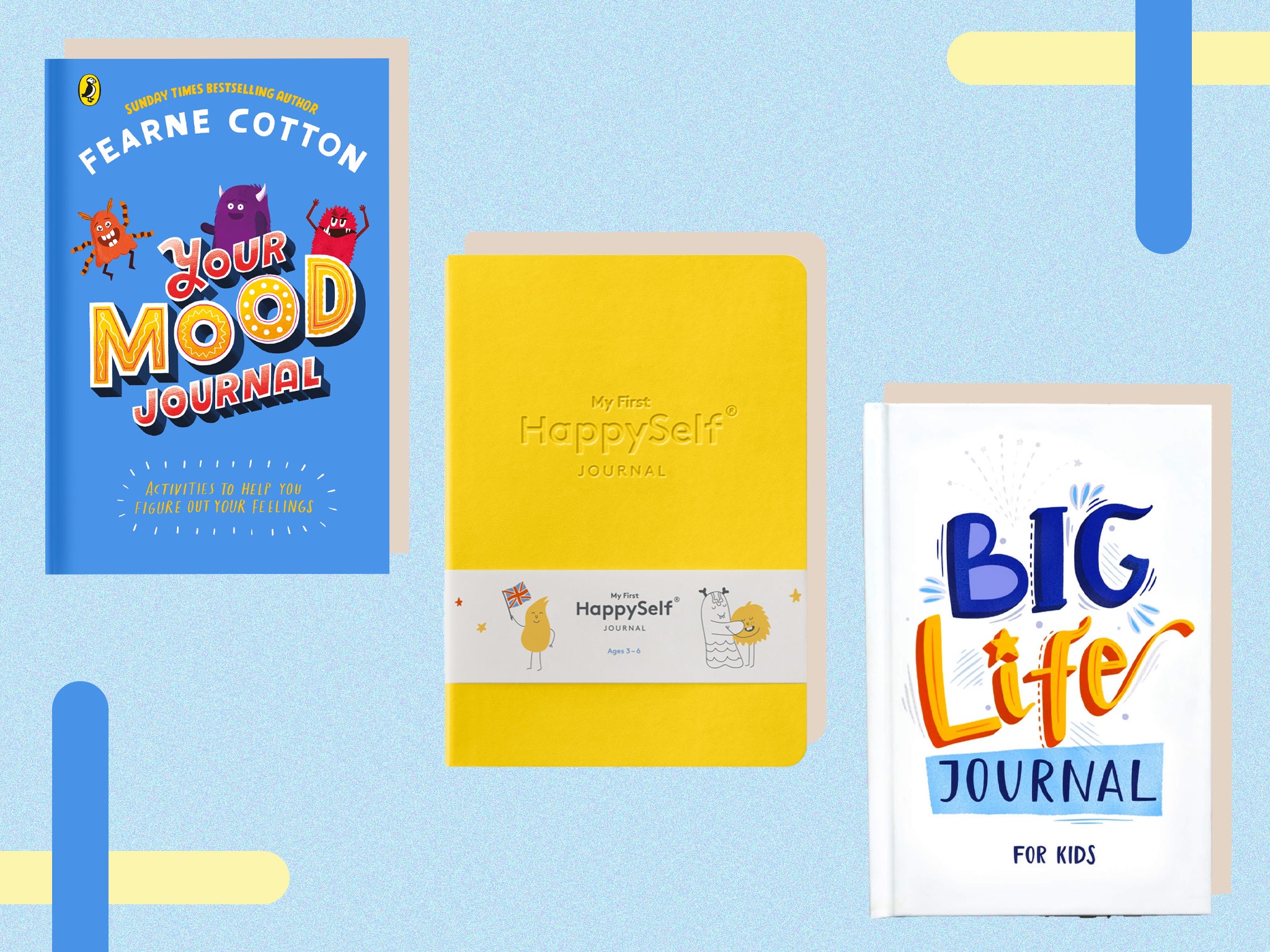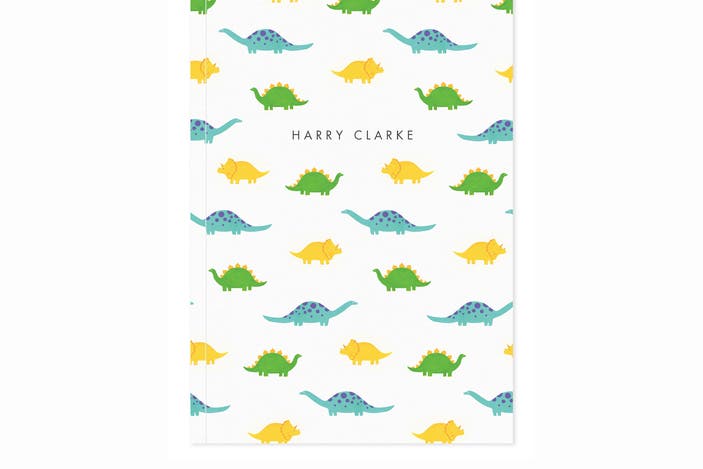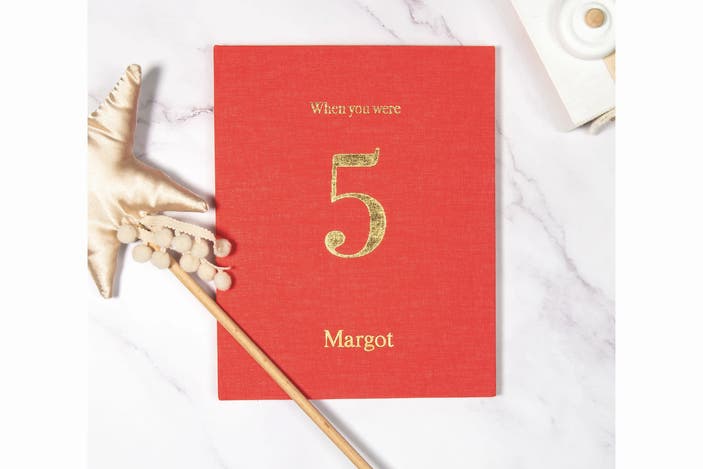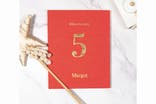The Independent's journalism is supported by our readers. When you purchase through links on our site, we may earn commission. Why trust us?
15 best kids’ journals to draw in and write down their feelings
Encourage children to write down their thoughts, worries, goals and more

It’s not always easy for children to verbalise what they’re thinking, whether it’s recounting a school day in more detail than monosyllables or discussing fears and worries they’re anxious about.
Like the rest of us, children have experienced strange times over the past year, with schools closing and opening and their education, extracurriculars and social lives regularly disrupted.
There are reports of rising stress and anxiety in youngsters, manifesting in anger, withdrawal and even tic disorders, according to the British Paediatric Neurology Association, as a result of lockdowns. While many are excited to return to school, others are feeling nervous about where friendships stand after months apart.
Starting a journal is one way kids can process what’s happening around them, writing down their observations, fears, memories and goals. Journals can help children develop a growth mindset and a gratitude practice from a young age, as well as improving their communication and writing skills.
“Keeping a journal is great for making sense of the world. Writing things down helps you to focus, to think clearly and to understand the way you feel,” says Mary Richards, publisher at Agnes & Aubrey, author of the Take Me series of journals for kids and a mother of four.
Read more:
- 10 best Stem toys: Help kids to learn while they play
- 9 best smartwatches for kids that have games, cameras and trackers
- 6 best kids’ clothing rental services for shopping more sustainably
- 12 best children’s books with empowering black characters
- Books to get kids talking about mental health
“As an adult, I love looking back at my childhood writing and drawing – it connects me straight back with how I was feeling at the time.”
The journals of 2021 are nothing like the spiral notebook diaries of yesteryear: now, you’ll find themed journals, focusing on everything from mindfulness and confidence-boosting to outdoor nature adventures. There are travel journals, worry journals and activity-packed creative journals to entice those kids who aren’t keen on writing.
Many of them include fun facts, inspiring stories and uplifting mantras, quotes and affirmations. Some of these journals can be personalised as an extra-special keepsake. There are also memory journals that parents can fill in with their little ones.
We tested a wide variety of journals with children aged 10, eight and five over several weeks, and are pleased to say that our kids have adopted a daily journal writing practice as a result, something they find enjoyable and calming.
The beauty of journals for kids is that there’s no right or wrong way to use them: kids can draw, scribble, circle an emoji to describe how they’re feeling or write pages of thoughts down – it’s an activity that can take as little as five minutes a day. Or, it’s something older children might want to spend an hour doing to unwind each evening.
Wondering how to get started? “Don’t worry about writing the same amount – or even anything at all – every day. You can use your journal to write very short notes – perhaps just a few words – to sum up how you’re feeling. You can take a break for a few days or even for a week, and then come back with new ideas,” advises Richards.
You can trust our independent reviews. We may earn commission from some of the retailers, but we never allow this to influence selections, which are formed from real-world testing and expert advice. This revenue helps to fund journalism across The Independent.
1Wee Society Be: My mindfulness journal

Wee Society’s vibrantly hued Be: My Mindfulness journal is a total delight: it’s well-priced for a hardback, and combines facts with writing, activities and more. Our eight-year-old tester is obsessed with this journal, which taught her about the amygdala and hippocampus, urged her to invent her own mantra and has removable connection cards to encourage listening to others.
It also highlights mindful breathing techniques, mindful eating and gratitude practices, and even the cover can be coloured in and turned into a poster – every detail has been considered, and the more you delve into it, the more impressed you’ll be. Plus, it gets kids writing daily without it feeling like a chore. Wee Society also has Go!, an adventure journal, Me!, a compendium, Write On!, a story journal and Yay!, a celebration journal – all equally colourful and inviting.
2My First HappySelf journal

Full disclosure: we’ve been fans of this mindfulness/gratitude journal for years, having first purchased it for our children soon after it launched in 2017. Since then, HappySelf has launched a couple of new varieties, although the cheery yellow, six-to-12-year-old journal is still available. Now, you can also find a 12+ Junior edition and a larger journal for three-to-six-year-olds, My First HappySelf journal, plus new colourways, like turquoise and dark blue.
We’re particularly impressed with this one though, which uses cute characters to encourage kids to identify their emotional state (the older kids version uses emojis). There are inspiring quotes (“And all the colours I am inside have not been invented yet,” Shel Silverstein), and it’s really user-friendly, as kids are encouraged to write about something good that happened to them each day, as well as doodling away on the Fun Pages. This one has been so popular in our household that our eight-year-old tester has claimed it for herself (even though it’s meant to be the five-year-old’s), and is using it nightly. We also love the soft moleskine cover and elastic strap. These are designed to last for around three months of daily use.
3Agnes & Aubrey Take Me To School: A school journal for young explorers

This beautifully illustrated journal from Mary Richards is one in a series: you’ll also find Take Me to Museums, Take Me Home, Take Me on Holiday and Take Me Outdoors. Wonderfully portable, this journal doesn’t skimp on style: unlike most of the kids’ journals that embrace bright primary colours, this is all highlighter-neons and soft pastels. As parents, what appealed to us in particular was the educational component: there are loads of facts on the school theme, with info about pioneering teachers throughout history and how uniforms differ from one country to the next.
There’s plenty of space for kids to write down their feelings, friendships and more, with helpful prompts to encourage observation and imagination. Each journal holds five adventures; we’re confident there will be at least one journal in this set your child will like. Bonus points for how easy it is to slip into a bag.
4Happy Confident Me journal

Written by psychotherapist Annabel Rosenhead and parenting coach Nadim Saad, Happy Confident Me is designed to be used for just five minutes a day over 10 weeks, to build up your child’s gratitude practice and help them identify their different emotions and form positive habits. While the prompts change from one day to the next, we like that one thing remains consistent: kids are encouraged to write three good things that happened each day.
After seeing our two older testers using it for a little over a week, it was interesting how they were already starting to reframe situations to have a more positive outlook, and were talking about themselves with more confidence. We also like the inspirational quotes on each page, from the likes of Oscar Wilde and Brené Brown, as well as the blank pages: there’s plenty of space to draw and write on dots, lines or grids.
5Big Life Journal

This journal encourages the development of a growth mindset in children, with 10 chapters covering topics like how mistakes help you grow, as well as be unique, be you. We love how it encourages the kids to write kind words describing themselves, and list their superpowers: our heart melted when we saw our eight-year-old had written:
“I love myself because I am unique” and noted that one of her superpowers was being “brave.” In addition to encouraging this positive mindset and self-love practice in kids, this journal is filled with amazing stories of inspiring people who have overcome adversity to achieve their goals. There’s also a slimline Daily Edition for kids, bursting with perky, bright illustrations.
6Wonderbly You are Extraordinary journal

This personalised journal is one for kids to treasure. Packed with fun activities like quizzes, made-up dictionary words using your child’s name, business cards to design, games, fail vouchers and more, it’s personalised throughout, so your child will always feel extra-special when they use it.
Our 10-year-old filled out half the pages in hers in a matter of days. It doesn’t require lengthy writing, simply a word here, a couple of sentences there. Hours of self-esteem enhancing fun – what’s not to like? It’s printed on part-recycled paper and available in softcover or hardcover (£29.99). Plus, you can include a dedication and preview the book online before ordering.
7Fearne Cotton’s Your Mood Journal

Fearne Cotton’sYoga Babies is one of the best picture books for encouraging mindfulness in little ones, so we were excited to trial her latest kids’ offering, Your Mood Journal, which is broken up into seven chapters, each one tackling a different emotion like anger, happiness or loneliness.
Stickers at the front got our mini-reviewers excited, while each emotion is made visual with the help of an illustrated character. The book is bursting with exercises encouraging kids to explore each of the emotions through words, activities and drawings. At over 200 pages long, it’s thorough – the only downside is that the chunkiness of the book means it’s a bit trickier for little hands to write on than some of the alternatives. We’ve taken to reading it for bedtime stories: picking an emotion and discussing a couple of pages a night with our testers.
Our 10-year-old dove right into the worry chapter – she was trying to get on top of anxieties about heading back to school – and even our three-year-old, who can’t yet hold a pencil, enjoyed this one thanks to the physical prompts to channel her anger and excitement into energetic air punches and jumps.
8Oakdene Designs personalised children’s time capsule journal

One of the winners for our eight-year-old tester, this spiral-bound time capsule journal has a personalised cover (printed onto recycled board), and pages where kids can fill in a couple of lines about what happened to them each day, as well as their mood, across 52 weeks.
You’ll also find “all about me”, “letter to my future self” and “gratitude” pages, as well as space for drawings or photos throughout. Our tester particularly enjoys this journal because it’s so manageable: she can use it daily, even when she’s exhausted (the mood slot after the first day of school was “tired”) because there are only a couple of lines to write in. A great intro to daily journaling, and a lovely gift thanks to the personalised aspect.
9Tiny Explorers: Into the Wild, Outdoor activity book and companion workbook

This nature activity book and companion journal set isn’t a typical diary. Rather, these books will equip children with everything they need to make a nature journal of their own, which will help give outings with the kids a new energy and purpose. Miro Tartan’s whimsical watercolour illustrations are charming, as are the craft suggestions, like making a wind chime out of a tree branch or foraging for ingredients to prepare a colourful “meal” of sticks, stones and leaves (a particular favourite with our testers).
Each activity is ranked by messiness, time and effort required. The companion workbook is filled with labels for the various activities, so kids can cut out and paste them into their nature journals. We think these books will encourage the kids to spend more time outside, as well as getting them into the mindful practice of journaling each week. The perfect activity over spring half-term and summer hols.
10My Kids Tribe: My Worry Journal

This spiral-bound journal is slim and portable – it’s flimsier than the other designs we tested, but it’s worth a mention because it works in a rather unique way. The child writes down a worry on each page, with space for shading in how worried they feel and for elaborating on why they’re stressed. They leave the journal next to their bed and the worry Oowl (aka a parent) writes back that evening.
We’ve been doing this for the past couple of weeks with a couple of our testers, who seem particularly excited to get a response from the owl the next day. Our eight-year-old tester also responded to the name of the journal: she liked that it was a designated space for her worries, and felt she’d been missing that. This is a good one for bridging any communication gaps between parents and their children.
11From You to Me Journals Rant & Rave My School journal

This soft cover journal is just the coolest: open from one side and rave about everything you love. Flip it over, and rant about everything you find irritating. The journal comes in two versions: School and Holiday, and the former has been helping our eight-year-old, who was feeling some trepidation about returning to school after several weeks of home learning. She’s been writing down her worries and stresses, concerns over whether friendships will suffer... and she’s also been channelling happier thoughts for the Rave side. Bonus: it’s the most budget-friendly journal with prompts we’ve come across.
12Create your own kindness: Activities to encourage children to be caring and kind

Somewhere between an activity book and a kindness journal, this new release from children’s therapist Becky Goddard-Hill will appeal to kids aged five-10, who can use this book to colour, doodle, draw and write. Each section starts with a famous quote, followed by some background info on a subject, which could be anything from Tai-Chi to how laughter helps our cortisol levels decrease. There are some clever activities in here, designed to capture the imaginations of youngsters.
Our three testers were particularly enamoured with the idea of creating their own kindness cake, writing down everything they’d put in, from thoughtfulness to hugs. We’ll be baking an edible version of ours this weekend. The book can be dipped in and out of, and doesn’t need to be done in any particular order.
13Papier personalised dinosaurs notebook

Unlike the other kids’ journals we tested, Papier’s notebooks were the simplest: lovely hardback designs with catchy cover art – think prints of dinosaurs or ladybirds – as well as collaborations with beloved kids’ book characters like Miffy. There are tons of cover styles to choose from, so we’re sure you’ll find one to appeal to a child of any age or gender.
You can choose from lined, plain or dotted for the interior pages, as well as personalising the front cover with up to two lines of text. Our older testers really liked the sturdiness of these journals, which were among the hardiest of the bunch. They’re less good for taking outside (although soft cover versions are available, for £16.99).
14Colour Chronicles The Book of You

This journal is designed as a keepsake memory book for parents and their little ones, going all the way from a child’s first through 16th birthday. While parents can certainly fill it in on their own, especially with younger kids, we’ve been doing ours with our five-year-old, chatting about her favourite hobbies and subjects, best toys and recent accomplishments. It’s very well constructed and comes in a rainbow of colours to choose from, with a hardbound natural woven rayon cloth cover. There’s a version for baby’s first year, too.
15Meminio When You Were Record book

Meminio’s darling collection of personalised journals is designed to record memories from those early years (which you’re guaranteed to forget otherwise, after so many nights of broken sleep). The lovely hardback books look delightful, with a linen cover in a selection of colours, gold-leaf text and a personalised name or initials (up to 10 characters), for an extra £5.
While these are designed for parents to fill out, or parents and children to do together, our five-year-old grabbed hers and started writing in all of the details herself, drawing self-portraits and pictures of her home and jotting down everything from her favourite activities (Lego) to her favourite foods (pasta, of course). There are special sections for Things you said that made us giggle, Christmas, holidays and – the biggest event of the year – your child’s birthday party.
The verdict: Kids’ journals
Wee Society’s Be: My Mindfulness journal is a favourite for its colourful illustrations, hardback design and fun prompts, plus it appeals to a large age range. We also love the fun educational tidbits and gorgeous colours in Agnes & Aubrey’s Take Me to School journal, another well-priced design (it costs under a tenner). If you want to spend a bit more on a journal, or get it as a special gift for someone, then we’d recommend My First HappySelf journal or Wonderbly’s personalised You are Extraordinary journal – both keepsakes the kids will want to write in, and hold onto after.
We’ve also found the best kids’ activity books that are both fun and educational















Bookmark popover
Removed from bookmarks